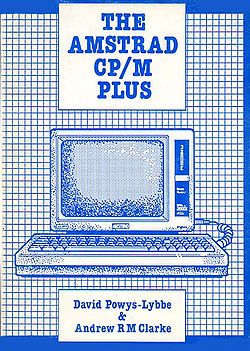A in depth book about using CP/M plus on Amstrad computers.
Information
| Title: |
The Amstrad CP/M Plus
|
| Authors: |
David Powys-Lybbe - Andrew R.M. Clarke
|
| Publisher: |
M.M.L. Systems Ltd.
|
| Year: |
1986
|
| Pages: |
530
|
| ISBN: |
1-86991-005-2 ( paperback )
|
| ISBN: |
1-86991-000-1 ( ring binder )
|
Contents
Section 1 Introducing CP/M
- Chapter 1.
- The history of CP/M.
- The genesis of the first portable operating system.
- The evolution of the concept of the BIOS.
- CP/M 1.3, CP/M 1.4 The arrival of the 5 1/4 in. drive and the idea of the disk parameter table.
- (CP/M 2.2). MP/M, the multitasking CP/M, The 8088/86 revolutions (CP/M-86).
- MSDOS and the market gap.
- Concurrent CP/M; the gap widens.
- The attempt at a graphics operating system (GSX).
- CP/M+, the state of the art. CP/M goes visual (GEM).
- The Unix diversion. CP/M-68K
- Chapter 2.
- CP/M computers. The CP/M-lookalikes.
- Turbodos, TPM, CDOS, and MSDOS.
- The effect of hardware standardisation.
- The major software running under CP/M.
- Spreadsheets, wordprocessors, and databases.
- The arrival of integrated software. CP/M and MSDOS.
Section 2 Using CP/M
- Chapter 3.
- Getting started. How to switch on.
- How to copy a disk. How to run a program.
- How to type a file.
- ..copy a file, ..change disks, ..change the contents of a file, ..delete a file, ..format a disk, etc.etc..
- Chapter 4.
- The CP/M commands. the built-in commands and transients. How to use PIP, SID, MAC, ED, DIR, INITDIR, SHOW SET etc.
- Chapter 5.
- Communications using CP/M. Serial Ports. Parallel ports. Modems etc. Connecting with other computers. The usefullness of PIP. Bstam, Xmodem, Ascom, Modem7, etc.
Section 3 Writing CP/M Software
- Chapter 6.
- The CP/M languages. How to interface with CP/M from a high level language.
- How to write well mannered CP/M software.
- Dos and donts.
- Chapter 7.
- The BDOS functions and their calls. The BIOS functions and their calls.
- Chapter 8.
- Extending the operating system.
- Why use RSXs? How to write RSXs.
- Writing a background spooler.
- Chapter 9.
- GSX and how to use it.
- Device independence in grahics and the GKS interface.
- Writing portable graphical software.
Section 4 Running common CP/M software
- Chapter 10.
- Using BDS C, Small C and Aztec C. Using BASIC-E MBASIC and CBASIC.
- Using Algol-M and Pascal MT+ etc.
- Chapter 11.
- Using a relocatable macroassembler. Using macros and maintaning a library of routines.
Section 5 CP/M Users referance
- Appendix A The CP/M Assemblers. Macros and pseudoops.
- Appendix B Introduction to BASIC-E the CP/M basic.
- Appendix C The CP/M Plus implementation on the Amstrad 6128 and 8256
- Appendix D The Amstrad Utilities.
- Appendix E The internal working of the CCP - an insight.
Tables of BDOS and BIOS functions
- BDOS Character Functions
- BDOS Drive Functions
- BDOS FCB and Directory Functions
- BDOS Date and Time Functions
- BDOS System Control Block Function
- BDOS System and Miscelleneous Functions
- BDOS Pseudo Functions
- BDOS Character Functions
